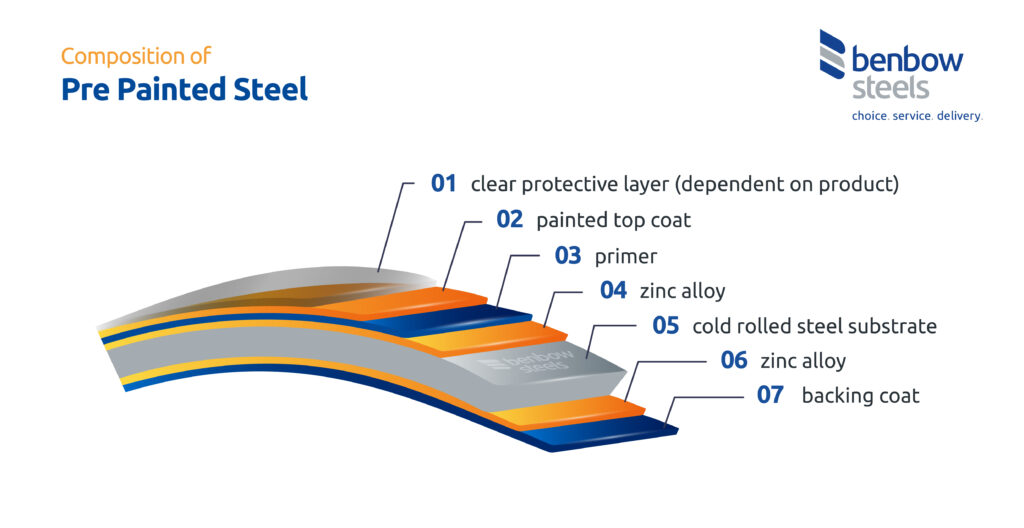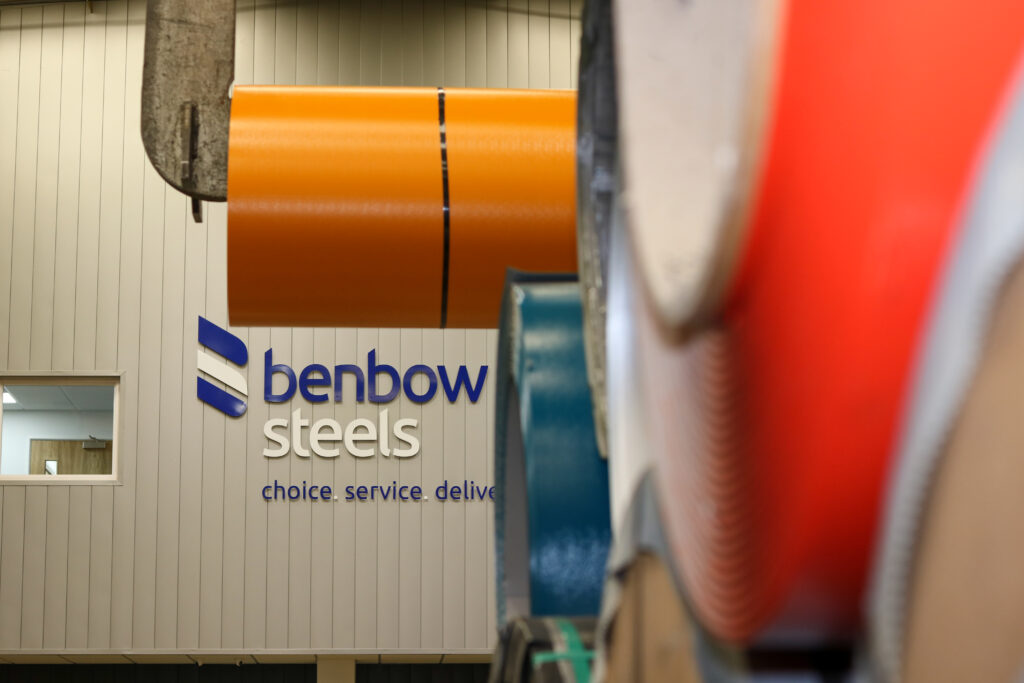Have you ever wondered how many layers pre painted steel has and why?

Pre painted steel (aka coated steel: organically coated steel: paint coated steel) is made up of several different layers with each type of product differing in both the thickness and the properties of each layer. Each product type also comes in a multitude of different colours which means there’s an almost infinite choice to be had when deciding which is the most suitable product for your project.
Different environments have different requirements from each layer, for example the requirements for the material if it’s used internally in a cold food store are different to those if it’s used externally on a building on the sea front in Cornwall.
The whole product, and each layer, has undergone a multitude of tests to ensure it is rigorous at its job and there are many standard regulations that cover the product, in both its final form and each layer. For example EN10169 covers the performance of the product in terms of UV and corrosion resistance and EN13501 for the classification of fire performance.
What Is Each Layer of Prepainted Steel?
Starting from the centre-
The Cold Rolled Steel Substrate (Layer 05)
The steel has already undergone significant processing to get to this stage. Typically originating from a Blast Furnace & BOC process, the slabs are hot rolled to create thin steel coil and then cold rolled to create steel sheet at the desired thickness/ gauge. The cold rolling process creates a thinner material and is used to refine the properties of the finished product.
The properties of this layer will depend on the final application. Although 76% of cold rolled sheet goes into the construction industry according to ECCA other applications include transport, appliances, furniture, road signs to name just a few.
Zinc Alloy (Layers 04 & 06)
This layer is critical in providing protection to the steel and can provide excellent corrosion resistance even on the cut edges. It can be 100% Zinc but is often made up of Zinc & Aluminium and the exact proportion of each is unique depending on the supplier and the product.
Tata Steel (as British Steel) first adopted this alloy layer for their high build products in 1998 with their trademarked Galvalloy® metallic coating.
Some products, such as ArcelorMittal’s Optigal® product also include Magnesium in this alloy for additionally properties.
Surface Treatment
The coil undergoes a surface treatment, on the front and back, before being presented to the next painting process to ensure that the next layer can be adequately bonded to the zinc layer.
Primer (Layer 03)
Primer is typically only added to the top of the steel as it ensures a strong adhesion with the top layer of paint. It may also be added to the bottom layer depending on the environment the finished product will be in and type of base coat being added.
Backing Coat (Layer 07)
The thickness, appearance and qualities of the backing coat is entirely dependent on the end use of the product.
In some cases the base/reverse side of the steel sheet will be visible to the end consumer in which case the material needs to meet aesthetic standards as well as meeting corrosion and fire standards, for example in some agricultural buildings.
In other cases the base of the steel is covered by another product, for example to create a composite panel, and so the function of the material is extremely relevant but the aesthetics are not so. Here the backing coat would need to provide long term protection to the steel, protect it from corrosion & mechanical damage during the panel creation process and provide excellent adhesion for the panel core.
Painted Top Coat (Layer 02)
For pre painted steel this is the layer that the end user will see and the key aesthetics come from a combination of the colour & design; the emboss style & depth (or whether to emboss at all); the gloss level.
The type and depth of emboss used depends on the supplier and offers a unique texture to the product. The depth of the emboss can be from 50microns but some emboss designs could trap dirt so the environment the finished product will be in must be considered when choosing an emboss type and depth.
Gloss levels are measured in GU and start from matt all the way to high gloss.
There are a multitude of different styles and colours available with most producers being able to colour match or create bespoke appearances for a large project.
Of vital importance to the end customer is the durability of this layer as the aesthetics of the material is as important in 20 years time as it is now. The requirements depend on the environment the material is in but typically end consumers look for: corrosion resistance (measured as RC); salt spray & humidity resistance; UV resistance (measured as RUV); abrasion resistance (wind, rain, sand); soil & pollutants resistance; flexibility of material; operating temperature; fire performance.
Clear Protective Coat (Layer 01)
Many products do not have a top coat as the majority of products are 2 layers (primer and topcoat) but this extra layer can add an additional layer of protection that increases UV protection, and therefore reduces the likelihood of colour fade, and scratch resistance. It is a clear layer so does not dilute or affect the colour underneath.

Find out how the layers are applied to pre painted steel during the coil coating process in the next blog…..